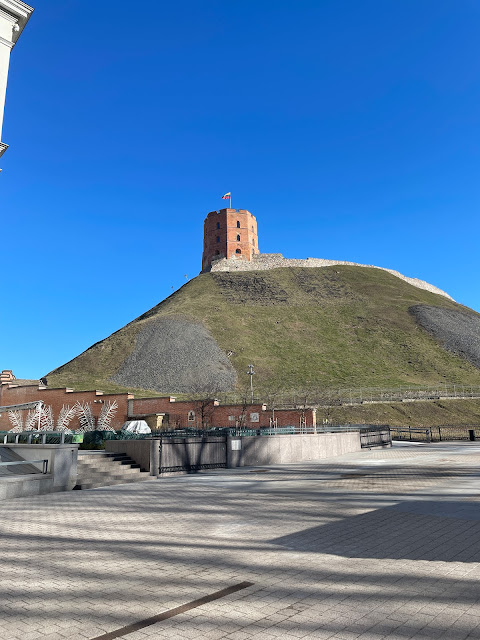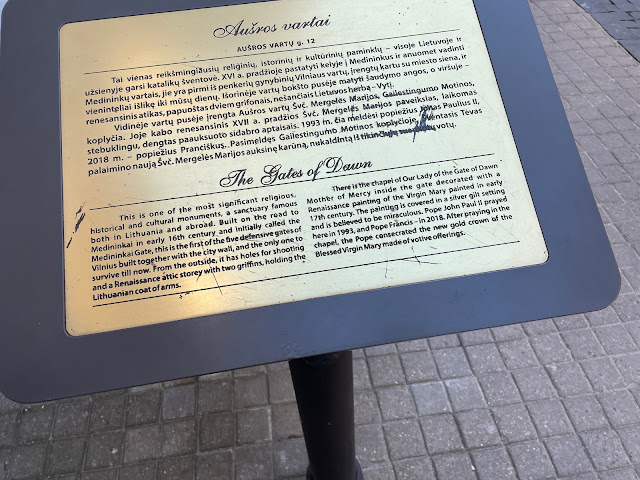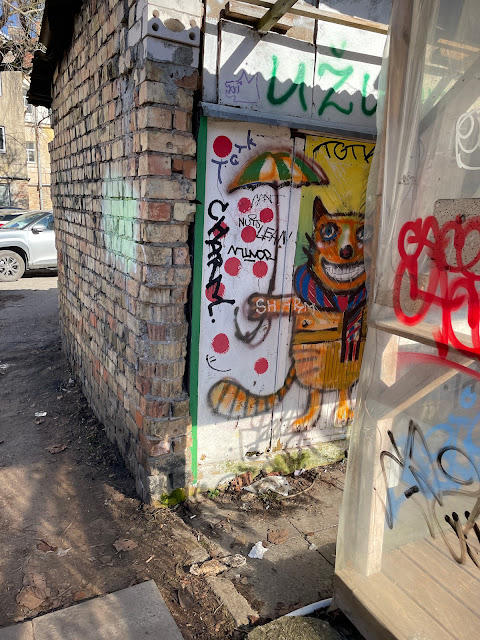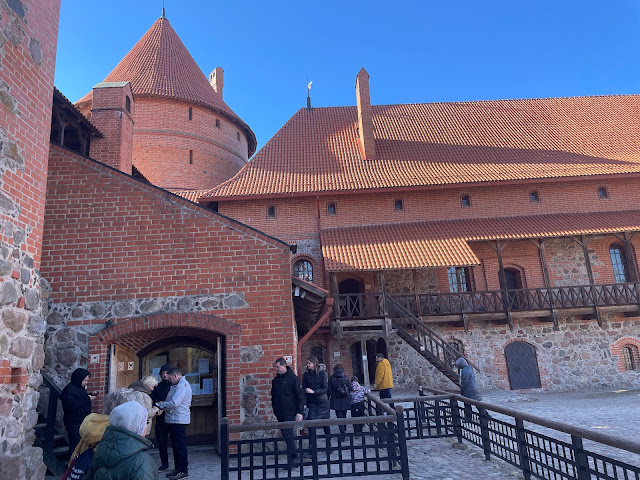The next morning we had a short drive into Vilnius old town. We found a park fairly easily and marked our location on our maps. We then started our walk towards our first stop - the Vilnius Cathedral.
The street was lined with a large number of market stalls selling food, baskets and other handicrafts. Our first thought was that this was just part of the normal Sunday markets, but more on that later...
 |
| Sushki a traditional Lithuanian and Ukrainian sweet bread |
Our first stop was the Vilnius Cathedral and Bell Tower. The Vilnius Cathedral is known by its full name: Cathedral Basilica of St Stanislaus and St Ladislaus of Vilnius (Vilniaus Šv. Stanislovo ir Šv. Vladislovo arkikatedra bazilika).
It was consecrated in 1783 and has been the site of the coronations of the Grand Dukes of Lithuania as well as the burial site of St Casimir, Grand Duke Vytautas and the heart of Polish King (and Lithuanian Grand Duke) Władysław IV Vasa (the rest of him is buried in Wawel Cathedral in Krakow).
Next to the cathedral is the Bell Tower (which was sounding its bells when we arrived). The Cathedral square also houses a bronze statue of Grand Duke Gediminas (one of Lithuania's first rulers) - made from bronze confiscated at the country borders, and the 'Miracle Stone'. The stone marking the start location of the "Baltic Way", a human chain made in 1989 linking Vilnius with Riga and Tallinn (690km long), which marked the start of the liberation of the Baltic States from the USSR. It is believed that 1-2 million people formed the chain (not bad when the population of the three countries in 1989 was about 8 million combined).
 |
| 'Stebuklas' (Miracle) |
 |
| Sculptures on the town hall |
 |
| Grand Duke Gediminas |
From the town hall, we walked past the Palace of the Grand Dukes of Lithuania:
and to the base of the Gediminias Castle Tower.
Directly in front of us was the Hill of Three Crosses (quite a few crosses less than the Hill of Crosses) (Kreivasis Kalnas).
A legend states that when Lithuania was a pagan country, seven Franciscan friars tried to convert the local Lithuanians and were beheaded on the hill (the known as Bald Hill - Plikasis kalnas). Wooden crosses were placed on the hill in the 17th century and were replaced as they rotted away. A concrete monument was built in 1916, but this was destroyed by the Soviets. It was rebuilt in 1989.
To our left was the castle. As I mentioned in the first section, this was the castle that Gediminias built after his dream of the iron wolf. The first castle was a wooden one, built in the 1300s. The first stone castle was built in 1409 by Grand Duke Vytautas.
The view from the tower hill was quite impressive:
 |
| Castle and funicular railway |
 |
| View north |
 |
| View west |
 |
| Panorama south |
 |
| South west to the Grand Duke Palace and Cathedral |
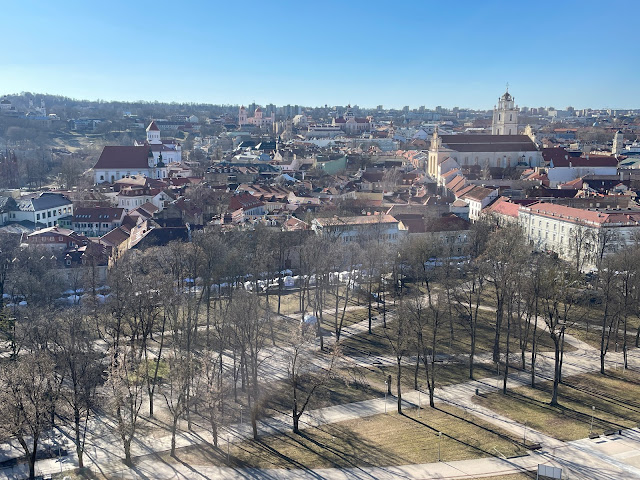 |
| View south |
 |
| A stone memorializing the rebels who were killed in the 1863-1864 uprising who were executed in the main square and buried here. |
 |
| Operating rules of the funicular - I had to laugh at the last one "It is prohibited to use the elevator when it is technically in bad order" |
After finishing at the castle and headed to our next destination - The Church of St John the Baptist.
Just a quick aside here - Tomas made a comment that really made me think a little. When we went to the IX Fort the previous day, he asked if I was deliberately seeking out holocaust memorials. I wasn't, but it was just a sign of how widespread the horrors of the war and the holocaust actually were. There were very few sites in eastern Europe which did not feel the impact of those years. His next question was why we were going to so many churches if we weren't religious. Many of these old towns were built around their churches and the churches were often the biggest, oldest and most ornate of all the old buildings as they needed to strike awe into the viewer. As such most of the old towns could be navigated by heading from church to church and in doing so, seeing the history and ornate architecture of the times.
But enough of my rambling, the next stop was the Church of St Johns, St John the Baptist and St John the Apostle and Evangelist (Vilniaus Šv. Jono Krikštytojo ir Šv. Jono apaštalo ir evangelisto bažnyčia). I guess it is handy to be able to group all your Johns together.
This church was built in 1388 and reconstructed in the 1500 and 1600s. It was seriously damaged in the fires in 1737 and completely rebuilt. As per most churches in Lithuania, the Soviets closed the church during their occupation.
While I had originally only had a few churches on my list, we kept stumbling across more and more. Wikipedia lists at least 53 churches in the city, which is impressive in a city of only 500,000.
So, the next stop was the Orthodox Church of St Paraskeva (Vilniaus Šv. kankinės Paraskevės cerkvė), which is the oldest Eastern Orthodox church in Lithuania.
It was built in 1346 and destroyed by fire in 1557, rebuilt and then burnt down again in 1611. The Orthodox church probably took the hint, because the ruins of the church were given over to the Catholics. They managed to keep it from burning down again, and handed it back to the Orthodox Church in 1655.
The church burnt down again in 1748 and was rebuilt but remained closed until it was rebuilt in 1864.
The bad luck continued, with the church being badly damaged in World War II and then closed by the Soviets after it had been repaired. For a while it housed a museum of Atheism, but it was re-consecrated in 1990 for the Orthodox Church. I'm surprised that they haven't banned smoking and open flames nearby...
From the oldest Orthodox Church, we headed to the oldest surviving church, Saint Nicholas Church (Mikalojaus bažnyčia). The church was built in the 1300s and when the Soviets closed the church, a statues was erected in the yard as a sign of resistance. The statue was St Christopher - and this was rebellious because the city's coat arm arms, which contained Saint Christopher, was banned.
We decided to take a quick break from churches to check out the Town Hall. The original town hall was created in 1432 but it went through many iterations before ending in the current design in 1799.
The break from churches did not last long, and we were soon at The Church of St Casimir (Šv. Kazimiero bažnyčia) and Jesuit House. It seems that most of the churches were 'oldest' in some category and this was no different, the church is the oldest baroque church in Vilnius - being built in 1618. The church also includes a Jesuit monastery:
As we headed towards our next major destination, The Gates of Dawn, we stopped at another interesting site, a gate named after Ignacy Domeyko.
Ignacy was born in 1802 and came to Vilnius to study. He was involved in secret political activism and was imprisoned. As punishment, he was banned from imperial service and put under police supervision. He spent the next six years farming, before returning to Vilnius after hearing of the November Uprising. He was involved in fighting for the uprising and narrowly avoided execution. After the war, he was a scientist.
Just outside the Gate of Dawn were two large churches - The Church of St Theresa (Šv. Teresės bažnyčia) and the Orthodox Church of the Holy Spirit (Vilniaus Šv. Dvasios vienuolyno katedra).
The Church of Saint Theresa was built in 1650, and the Church of the Holy Spirt was built in 1567 and rebuilt in 1749 after (you guessed it....) a fire.
 |
| Church of St Theresa |
 |
| Gates to the Orthodox Church of the Holy Spirit |
Just behind the Church of St Theresa is the Gate of Dawn (Aušros vartai). An important site of Catholic pilgramage, the gates are considered an important religious monument.
The gate was built in the early 1500s as part of the city walls. Ten gates were made in total, but only the Gate of Dawn remains. In order to protect the defenders, religious artifacts were stored in the gate, including a chapel which contains an image of the Virgin Mary, said to have healing powers and the destination of many pilgrimages.
 |
| The Icon of Virgin Mary |
Having finished our main sightseeing, we decided to head back via Užupis. Similar to Christiania in Denmark, Užupis is an independent republic of artists. The name means "Across the River"
The area was original a Jewish district that was destroyed in the war, with its occupants killed in the holocaust. The abandoned area became a slum and filled with squatters, prostitutes and the homeless. before a group of artists reclaimed the area and in 1997 declared independent (likely jokingly, since Užupis day is the 1st of April and the statehood is not recognised by any governments). The area has its own constitution, flag and an army of 11 men.
The flag of Užupis is a blue circle with a white hand holding a blue circle:
The Užupis constitution is displayed on the walls in the city and is as follows:
- Everyone has the right to live by the River Vilnelė, and the River Vilnelė has the right to flow by everyone.
- Everyone has the right to hot water, heating in winter and a tiled roof.
- Everyone has the right to die, but this is not an obligation.
- Everyone has the right to make mistakes.
- Everyone has the right to be unique.
- Everyone has the right to love.
- Everyone has the right not to be loved, but not necessarily.
- Everyone has the right to be undistinguished and unknown.
- Everyone has the right to idle.
- Everyone has the right to love and take care of the cat.
- Everyone has the right to look after the dog until one of them dies.
- A dog has the right to be a dog.
- A cat is not obliged to love its owner, but must help in time of need.
- Sometimes everyone has the right to be unaware of their duties.
- Everyone has the right to be in doubt, but this is not an obligation.
- Everyone has the right to be happy.
- Everyone has the right to be unhappy.
- Everyone has the right to be silent.
- Everyone has the right to have faith.
- No one has the right to violence.
- Everyone has the right to appreciate their unimportance. [In Lithuanian this reads Everyone has the right to realize his negligibility and magnificence.]
- No one has the right to have a design on eternity.
- Everyone has the right to understand.
- Everyone has the right to understand nothing.
- Everyone has the right to be of any nationality.
- Everyone has the right to celebrate or not celebrate their birthday.
- Everyone shall remember their name.
- Everyone may share what they possess.
- No one can share what they do not possess.
- Everyone has the right to have brothers, sisters and parents.
- Everyone may be independent.
- Everyone is responsible for their freedom.
- Everyone has the right to cry.
- Everyone has the right to be misunderstood.
- No one has the right to make another person guilty.
- Everyone has the right to be individual.
- Everyone has the right to have no rights.
- Everyone has the right to not to be afraid.
- Do not defeat.
- Do not fight back.
- Do not surrender.
 |
| The constitution in multiple languages |
 |
| Angel of Užupis |
St Anne's church as built in 1495 and the Bernardine Church (Church of St Francis and St Bernard) sits next to St Anne's and was built in the 1500s. The church was also part of the city defences.
 |
| St Anne's at the front and Bernardine at the back |
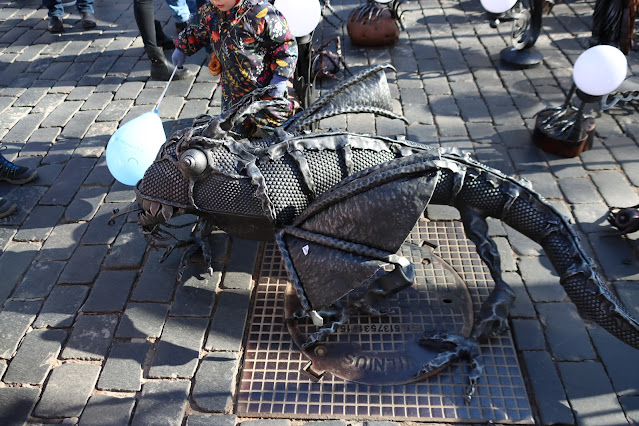 |
| Metalwork dragon for sale (only 2000 euro) |
 |
| Driving into Trakai |
 |
| The street just outside the castle |
 |
| Bridge to the castle |
 |
| The river was frozen |
 |
| Trakai Castle |
 |
| Kris lining up the perfect shot |
The corner towers were filled with cannon (15 in total in 1409). In 1410 the Battle of Gundwald was won and the castle lost its importance. Vytautas the Great moved his residence into the castle in 1409
 |
| Some of the treasures of the castle |
 |
| The spiral stairwell |
 |
| Where it lead to |
 |
| Bas-reliefs of the Lithuanian Rulers |
 |
| Items recovered from the castle |
The next room was the Grand Duke's Chambers with a display of weaponry recovered from the castle.
 |
| Model of the castle |














